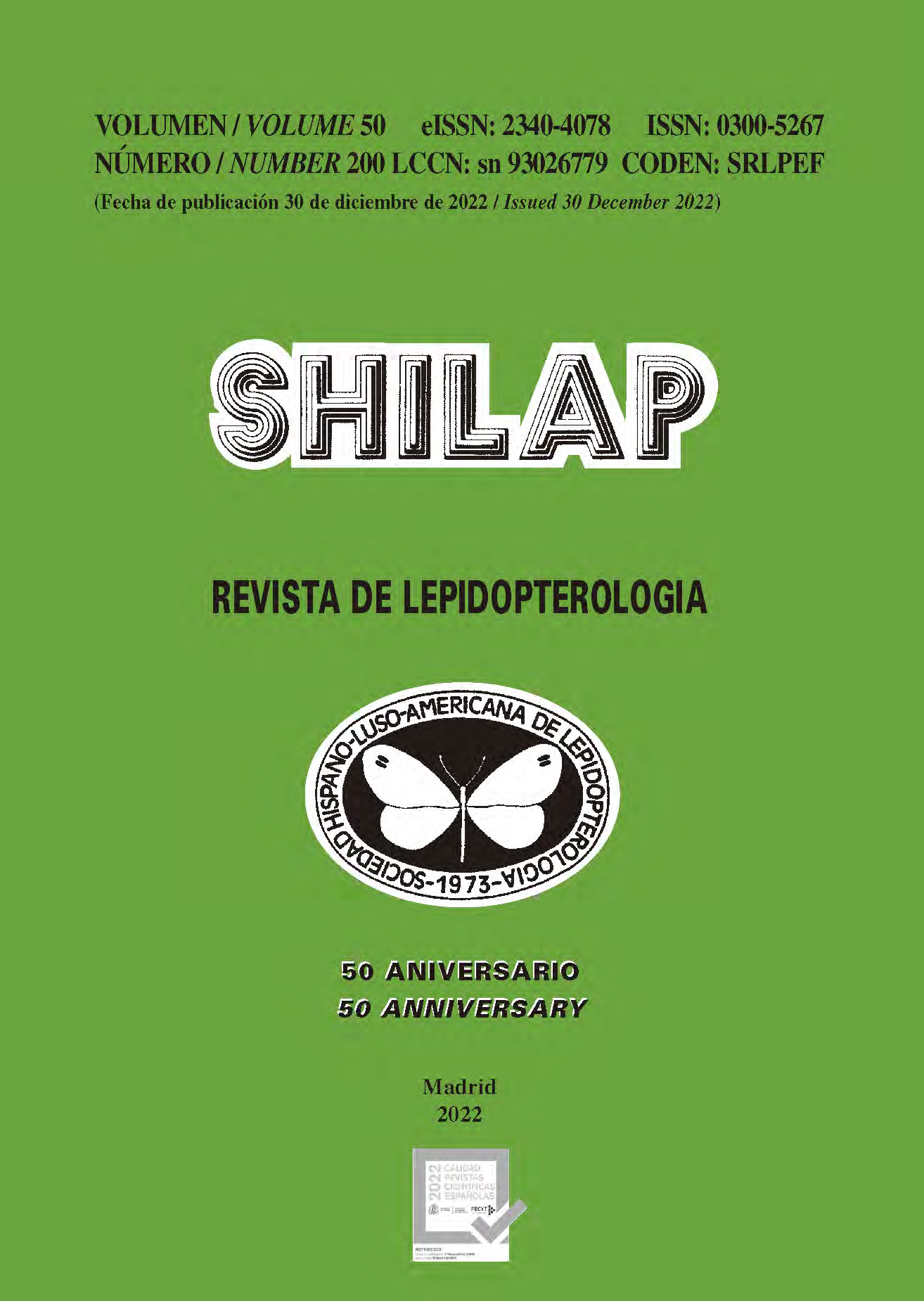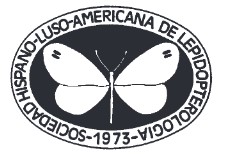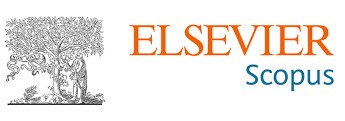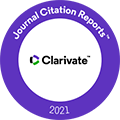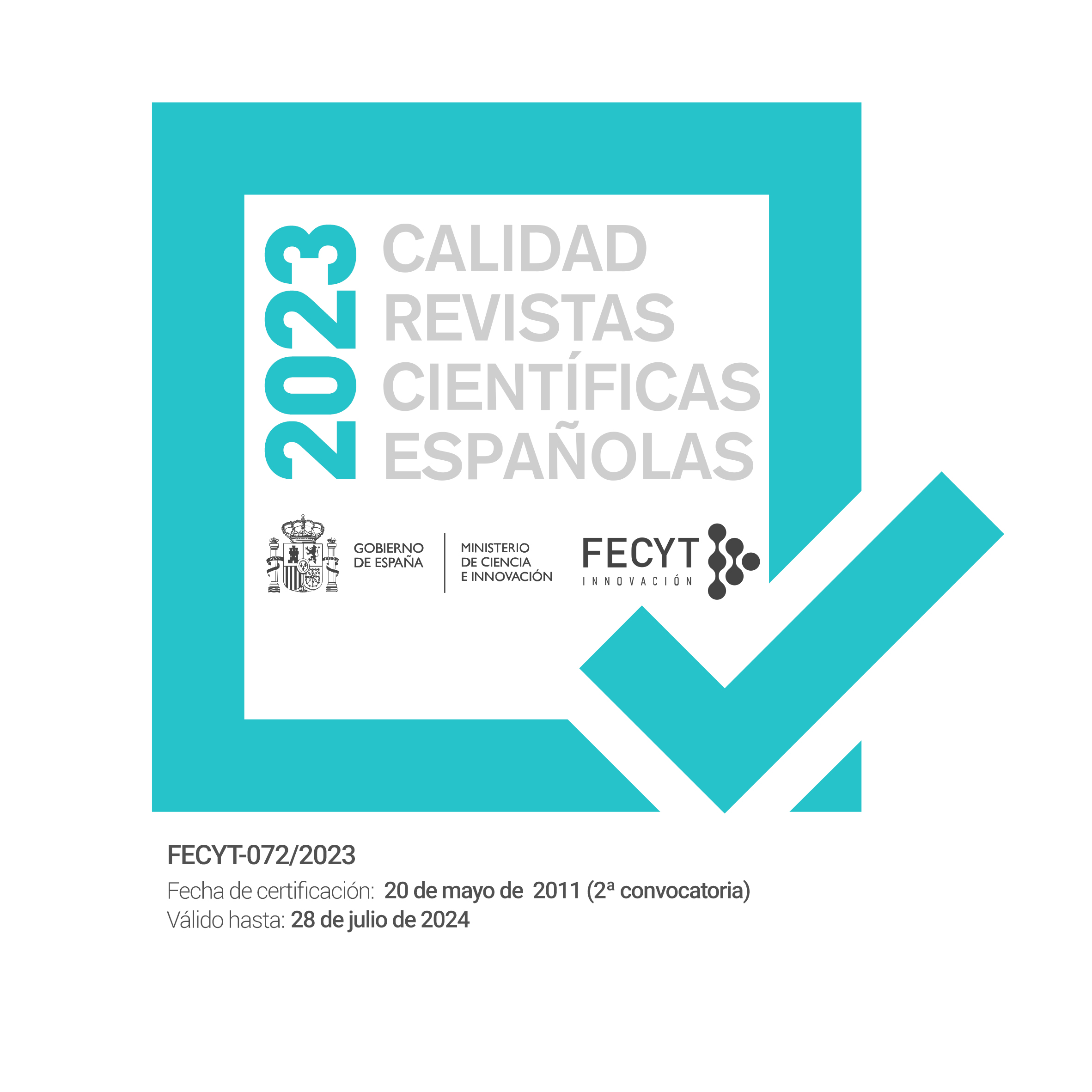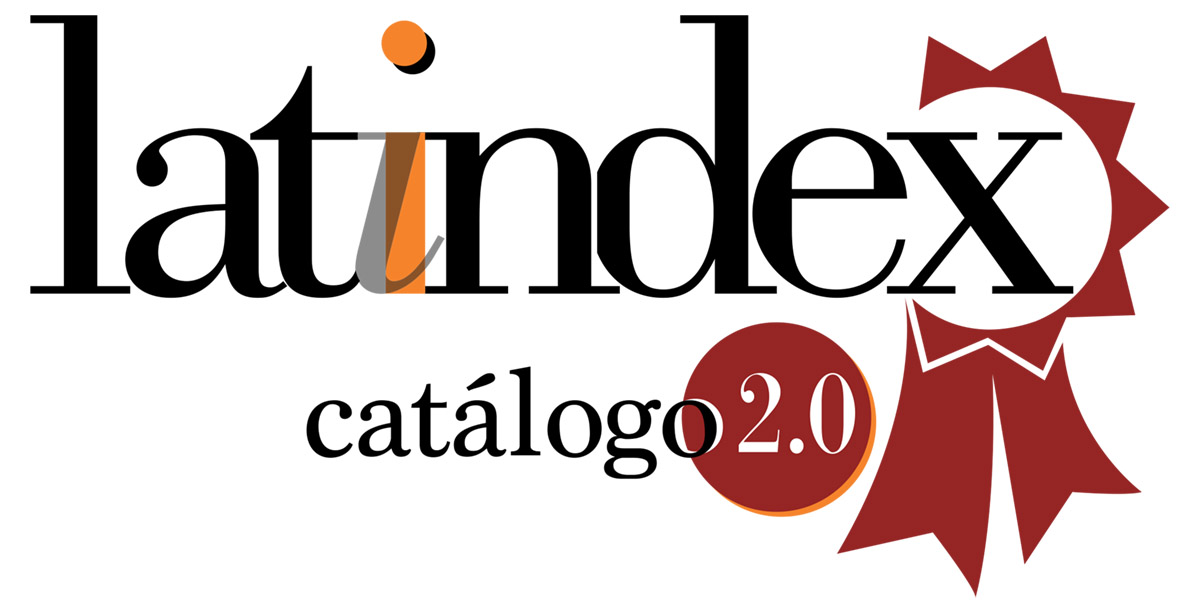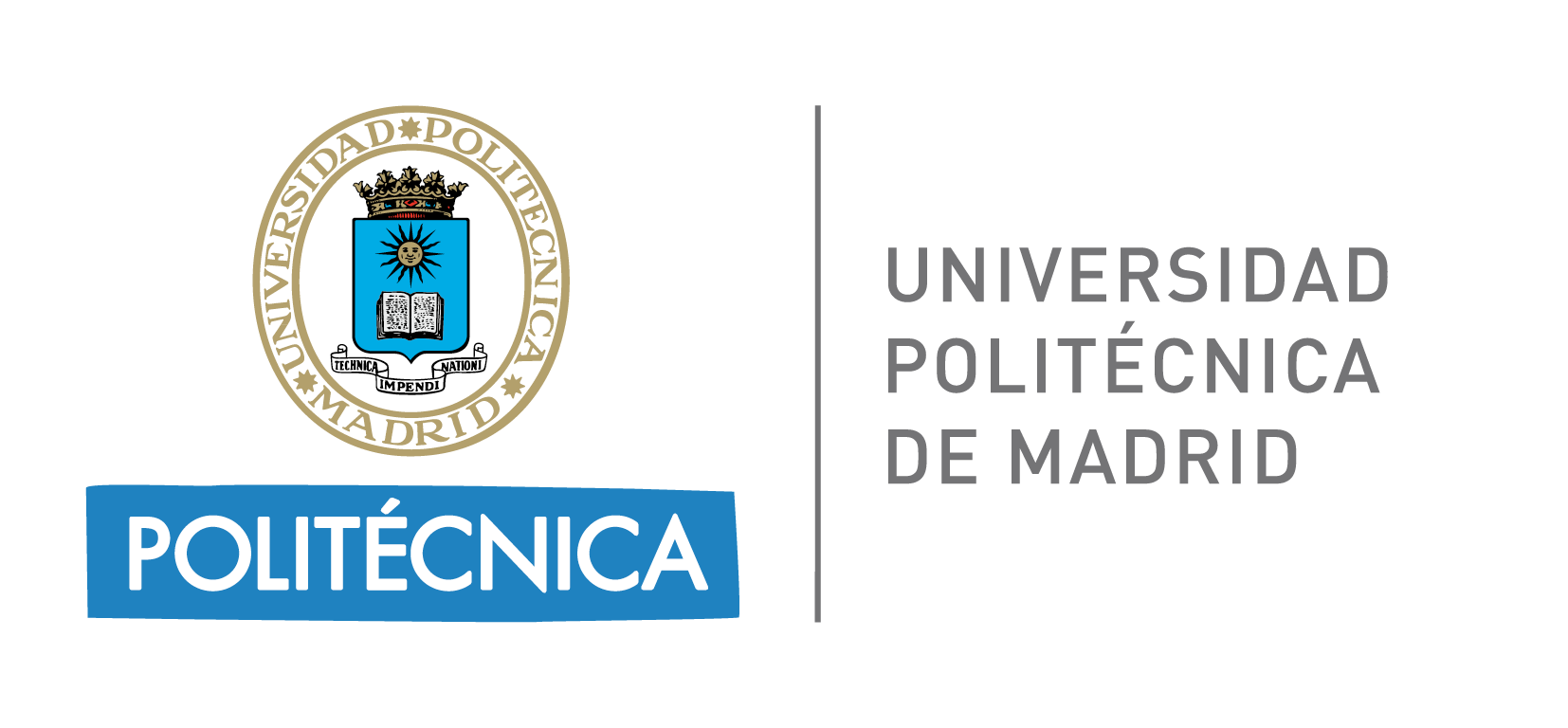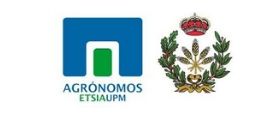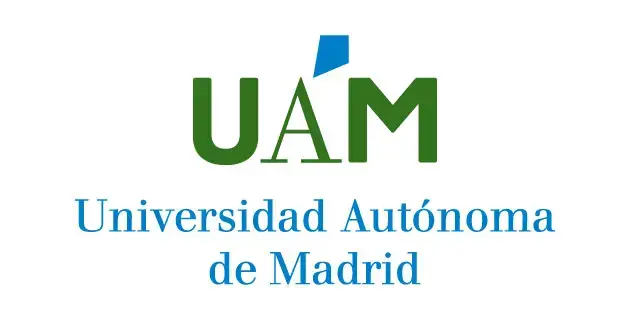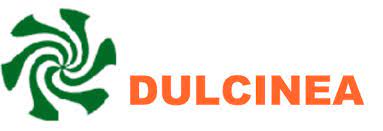Adult population fluctuation of Comadia redtenbacheri (Hammerschmidt, 1847) (Lepidoptera: Cossidae)
DOI:
https://doi.org/10.57065/shilap.265Schlagworte:
Lepidoptera, Cossidae, Comadia, ultraviolet light, trapping, MexicoAbstract
Comadia redtenbacheri (Hammerschmidt, 1847) is an insect highly regarded for its commercial and nutritional value. Adult fluctuation in a plantation of Agave salmiana Otto ex Salm-Dyck was determined using ultraviolet light traps. Trapped adults were counted weekly during three periods (December 2013 to December 2014, December 2014 to December 2015, and December 2015 to June 2016), and temperature and relative humidity were recorded. Adult population was present 157 days on average, from December to May, with peak capture on day 83. The average sex ratio of females to males was 1:14. Average environmental conditions that favoured the highest capture in the three periods were 17.8º C and 47.1% relative humidity. Knowledge of the period of adult presence and the influence of temperature and relative humidity are important for management and conservation of the insect population by farmers and gatherers.
Downloads
Globale Statistiken ℹ️
|
445
Aufrufe
|
356
Downloads
|
|
801
Gesamt
|
|
Literaturhinweise
Al-Deeb, M. A., Mahmoud, S. T., & Sharif, E. M. (2012). Use of light traps and differing light colour to investigate seasonal abundance of the date palm pest, Oryctes agamemnon arabicus (Coleoptera: Scarabaeidae). Journal of Economic Entomology, 105(6), 2062-2067. DOI: https://doi.org/10.1603/EC12141
Ancona, L. H. (1931). Los chilocuiles o gusanitos de la sal de Oaxaca. Anales del Instituto de Biología de la Universidad Nacional Autónoma de México, 2(1), 265-277.
Brown, R. M. (1975). A revision of the North American Comadia (Cossidae). Journal of Research on the Lepidoptera, 14(4), 189-212. DOI: https://doi.org/10.5962/p.280586
Cárdenas-Aquino, M. R., Alarcón-Rodríguez, N. Rivas-Medrano M., González-Hernández, H., Vargas-Hernández, M., Sánchez-Arroyo, H., & Llanderal-Cázares, C. (2018). Molecular delineation of the agave red worm Comadia redtenbacheri (Lepidoptera: Cossidae). Zootaxa, 4375(3), 358-370. DOI: https://doi.org/10.11646/zootaxa.4375.3.4
Castro-Torres, R. E., & Llanderal-Cázares, C. (2015). Principales caracteres morfológicos para el reconocimiento de Comadia redtenbacheri Hammerschmidt (Lepidoptera: Cossidae). Entomología Mexicana, 2(6), 798-803.
Castro-Torres, R., & Llanderal-Cázares, C. (2016). Detailed morphology of all life stages of the agave red worm, Comadia redtenbacheri (Hammerschmidt) (Lepidoptera: Cossidae). Neotropical Entomology, 45(6), 698-711. DOI: https://doi.org/10.1007/s13744-016-0425-7
CONAGUA (2020). Información de Estaciones Climatológicas. Estación 15090. San Jerónimo Xonocahuacan, Tecámac, Estado de México, México. https://smn.conagua.gob.mx/tools/RESOURCES/Diarios/15022.txt
Delgado-Tejeda, I., Llanderal-Cázares, C., Miranda-Perkins, K., & De Los Santos-Posadas, H. M. (2017). Pupación, emergencia de adultos y oviposición de Comadia redtenbacheri (Lepidoptera: Cossidae) en vivero. Agrociencia, 51(4), 447-454.
Durán, J. M., Alvarado, M., González, M., Jiménez, N., Sánchez, A., & Serrano, A. (2004). Control del taladro amarillo, Zeuzera pyrina L. (Lepidoptera, Cossidae), en olivar mediante confusión sexual. Boletín de Sanidad Vegetal de Plagas, 30(2), 451-462.
Espinosa-García, N., Llanderal-Cázares, C., Miranda-Perkins, K., Vargas-Hernández, M., González-Hernández H., & Romero-Nápoles, J. (2018). Infestación inducida de gusano rojo Comadia redtenbacheri en Agave salmiana. Southwestwern Entomologist, 43(4), 1009-1019. DOI: https://doi.org/10.3958/059.043.0418
Frost, S. W. (1957). The Pennsylvania insect light trap. Journal of Economic Entomology, 50(3), 287-292. DOI: https://doi.org/10.1093/jee/50.3.287
Hernández-Flores, L., Llanderal-Cázares, C., Guzmán-Franco, A. W., & Aranda-Ocampo, S. (2015). Bacteria present in Comadia redtenbacheri larvae (Lepidoptera: Cossidae). Journal of Medical Entomology, 52(5), 1150-1158. DOI: https://doi.org/10.1093/jme/tjv099
Hernández-Livera, R. A., Llanderal-Cázares, C., Castillo-Márquez, L. E., Valdez-Carrasco, J., & Nieto-Hernández, R. (2005). Identificación de instares larvales de Comadia redtenbacheri (Hamm) (Lepidoptera: Cossidae). Agrociencia, 39(5), 539-544.
Hienton, T. E. (1974). Summary of investigations of electric insect traps. Technical Bulletin Nº 1498. Agricultural Research Service. United States Department of Agriculture. Washington, D. C.
Ismail, I. I., Abou-Zeid, N. A., & Abdallah, F. F. (1992). Population dynamics of the leopard moth, Zeuzera pyrina L., and its control on olive trees in Egypt. Journal of Plant Diseases and Protection, 99(5), 519-524.
Llanderal-Cázares, C., Nieto-Hernández, R., Almanza-Valenzuela, I., & Ortega-Álvarez, C. (2007). Biología y comportamiento de Comadia redtenbacheri (Hamm) (Lepidoptera: Cossidae). Entomología Mexicana, 6(1), 252-255.
Llanderal-Cázares, C., De Los Santos-Posadas, H. M., Almanza-Valenzuela, I., Nieto-Hernández, R., & Castillejos-Cruz, C. (2010). Establecimiento del gusano rojo de maguey en invernadero. Acta Zoológica Mexicana (n. s.), 26(1), 25-31. DOI: https://doi.org/10.21829/azm.2010.261677
Llanderal-Cázares, C., Castro-Torres, R., & Miranda-Perkins, K. (2017). Bionomics of Comadia redtenbacheri (Hammerschmidt, 1847) (Lepidoptera: Cossidae). SHILAP Revista de lepidopterología, 45(179), 373-383.
Miranda-Perkins, K., Llanderal-Cázares, C., De Los Santos-Posadas, H. M., Portillo- Martínez, L., & Vigueras-Guzmán, A. L. (2013). Comadia redtenbacheri (Lepidoptera: Cossidae) pupal development in the laboratory. Florida Entomologist, 96(4), 1424-1433. DOI: https://doi.org/10.1653/024.096.0422
Miranda-Perkins, K., Llanderal-Cázares, C., Cadena-Barajas, M., & López-Sauceda, J. (2016). Adult emergence and reproductive behavior of Comadia redtenbacheri in confinement. Southwestern Entomologist, 41(3), 657-665. DOI: https://doi.org/10.3958/059.041.0308
Nielsen, A. L., Holmstrom, K., Hamilton, G. C., Cambridge, J., & Ingerson-Mahar, J. (2013). Use of black light traps to monitor the abundance, spread, and flight behavior of Halyomorpha halys (Hemiptera: Pentatomidae). Journal of Economic Entomology, 106(3), 1495-1502. DOI: https://doi.org/10.1603/EC12472
Nolasco, M. A., Jiménez-Luna, J. E., & Camacho, A. D. (2002). Inducción a la pupación y colonización del gusano rojo del maguey Comadia redtenbacheri H. (Lepidoptera: Cossidae). Entomología Mexicana, 1, 125-130.
Ramamurthy, V. V., Akhtar, M. S., Patankar, N. V., Menon, P., Kumar, R. K., Singh, S., Ayri, S., Parveen, S., & Mittal, V. (2010). Efficiency of different light sources in light traps in monitoring insect diversity. Munis Entomology & Zoology, 5(1), 109-114.
Ramírez-Cruz, A., & Llanderal-Cázares, C. (2015). Morfología del sistema reproductor de la hembra de Comadia redtenbacheri (Hammerschmidt) (Lepidoptera: Cossidae). Acta Zoológica Mexicana (n. s.), 31(3), 431-455. DOI: https://doi.org/10.21829/azm.2015.3131044
Ramos-Elorduy, J. (2006). Threatened edible insects in Hidalgo, and some measures to preserve them. Journal of Ethnobiology and Ethnomedicine, 2(51), 1-10. DOI: https://doi.org/10.1186/1746-4269-2-51
Ramos-Elorduy, J., Pino-Moreno, J. M., Vázquez, A. I., Landero, I., Oliva-Rivera, H., & Camacho, V. H. M. (2011). Lepidoptera in Mexico: Geographic distribution, ethnicity, economic and nutritional importance for rural people. Journal of Ethnobiology and Ethnomedicine, 7, 2-22. DOI: https://doi.org/10.1186/1746-4269-7-2
SAS Institute (2015). Statistical Analysis System. Copyright© SAS Institute Inc., versión 9.4. Cary, North Carolina.
Sermsri, N., & Torasa, C. (2015). Solar energy-based insect pest trap. Procedia-Social and Behavioral Sciences, 197(1), 2548-2553. DOI: https://doi.org/10.1016/j.sbspro.2015.07.620
Shimoda, M., & Honda, K. (2013). Insect reactions to light and its applications to pest management. Applied Entomology and Zoology, 48(4), 413-421. DOI: https://doi.org/10.1007/s13355-013-0219-x
Solomon, J. D., & Neel, W. W. (1973). Mating behavior in the carpenterworm moth, Prionoxystus robiniae (Lepidoptera: Cossidae). Annals of the Entomological Society of America, 66(2), 312-314. DOI: https://doi.org/10.1093/aesa/66.2.312
Solomon, J. D. (1976). Sex ratio of the carpenterworm moth (Prionoxystus robiniae) (Lepidoptera: Cossidae). The Canadian Entomologist, 108(3), 317-318. DOI: https://doi.org/10.4039/Ent108317-3
Szentkirályi, F. (2002). Fifty-year-long insect survey in Hungary: T. Jermy’s contributions to light-trapping. Acta Zoologica Academiae Scientiarum Hungaricae, 48(1), 85-105.
Tamiru, A., Getu E, Jembere, B., & Bruce, T. (2012). Effect of temperature and relative humidity on the development and fecundity of Chilo partellus Swinhoe (Lepidoptera: Crambidae). Bulletin of Entomological Research, 102(1), 9-15. DOI: https://doi.org/10.1017/S0007485311000307
Thomas, D. B. (2008). Nontoxic antifreeze for insect traps. Entomological News, 119(4), 361-365. DOI: https://doi.org/10.3157/0013-872X-119.4.361
Triplehorn, C. A., & Johnson, N. F. (2005). Borror and Delong’s Introduction to the Study of Insects. Thomson Brooks/Cole.
Truman, E. H. (1974). Summary of investigations of electric insect traps. Agricultural Research Service. United State Department of Agriculture. Technical Bulletin 1498.
Truxa, C., & Fiedler, K. (2012). Attraction to light-from how far do moths (Lepidoptera) return to weak artificial sources of light? European Journal Entomology, 109(1), 77-84. DOI: https://doi.org/10.14411/eje.2012.010
Yen, A. L. (2012). Edible insects and management of country. Ecological Management & Restoration, 13(1), 97-99. DOI: https://doi.org/10.1111/j.1442-8903.2011.00623.x
Zada, H., Saljoqi, A. U. R., Farid, A., Ullah, F., & Alikhan, I. (2014). Influence of weather parameters on population dynamics of apple codling moth Cydia pomonella (Lepidoptera; Tortricidae) at Matta Swat valley. Sarhad Journal of Agriculture, 30(3), 351-356.
Zetina, D. A. H., Llanderal-Cázares, C., Ruíz-Cancino, E., & Khalaim, A. I. (2009). Registro para México de Lissonota fascipennis Townes (Hymenoptera: Ichneumonidae), como parasitoide del gusano rojo del maguey. Acta Zoológica Mexicana (n. s.), 25(3), 655-657. DOI: https://doi.org/10.21829/azm.2009.253667
Zetina, D. A., Llanderal, C., & Huerta, H. (2012). Acantholespesia texana: A new report for Mexico, as a parasitoid of Comadia redtenbacheri Hamm. Southwestern Entomologist, 37(2), 235-237. DOI: https://doi.org/10.3958/059.037.0217
Zetina, D. A., & Llanderal, C. (2014). Signs and symptoms in Comadia redtenbacheri Hamm. (Lepidoptera:
Cossidae) larvae affected by parasitoids. Southwestern Entomologist, 39(2), 285-290.
Veröffentlicht
Zitationsvorschlag
Ausgabe
Rubrik
Lizenz
Copyright (c) 2022 Manuel Jiménez-Vásquez, Celina Llanderal-Cázares, Kalina Miranda-Perkins, Mateo Vargas-Hernández, Rosa María López-Romero, Manuel Campos-Figueroa

Dieses Werk steht unter der Lizenz Creative Commons Namensnennung 4.0 International.
Der Autor behält sich seine Marken- und Patentrechte an allen in diesem Artikel enthaltenen Verfahren und Prozessen vor.
Der Autor behält sich das Recht vor, den im SHILAP Revista de lepidopterología veröffentlichten Artikel zu teilen, zu verbreiten, aufzuführen und öffentlich zu kommunizieren, mit der anfänglicher Anerkennung der Veröffentlichung im SHILAP Revista de lepidopterología.
Der Autor behält sich das Recht auf eine spätere Veröffentlichung seiner Arbeit vor, von der Verwendung des Artikels bis hin zur Veröffentlichung in einem Buch, vorausgesetzt, er weist auf die Erstveröffentlichung im SHILAP Revista de lepidopterología hin.
Jeder Einreichung für das SHILAP Revista de lepidopterología muss eine Anerkennung des Urheberrechts und eine Bestätigung der Autorenschaft beigefügt sein. Mit ihrer Annahme behalten die Autoren das Urheberrecht an ihrer Arbeit und erklären sich damit einverstanden, dass der Artikel, wenn er von SHILAP Revista de lepidopterología zur Veröffentlichung angenommen wird, für die Nutzung und Verbreitung unter einer "Creative Commons Attribution 4.0 International" (CC BY 4.0)-Lizenz lizenziert wird, die es Dritten erlaubt, den Inhalt für jeden Zweck zu teilen und zu bearbeiten, wobei das Originalwerk angemessen zu erwähnen ist.
Eine informative Version und den Rechtstext der Lizenz finden Sie hier. Der Hinweis auf die CC BY 4.0-Lizenz muss erforderlichenfalls ausdrücklich auf diese Weise erfolgen.
Ab 2022 ist der Inhalt der gedruckten und digitalen Version unter einer "Creative Commons Attibution 4.0 International" (CC BY 4.0) -Lizenz lizenziert wird, die es Dritten erlaubt, den Inhalt für jeden Zweck zu teilen und zu bearbeiten, wobei das Originalwerk angemessen zu erwähnen ist.
Frühere Inhalte der Zeitschrift wurden unter einer herkömmlichen Urheberrechtslizenz veröffentlicht; das Archiv ist jedoch frei zugänglich.
Ao utilizar o conteúdo do SHILAP Revista de lepidopterología publicado antes do ano 2022, incluindo figuras, tabelas ou qualquer outro material em formato impresso ou eletrónico pertencem aos autores dos artigos, os autores devem obter a autorização do detentor dos direitos de autor. As responsabilidades legais, financeiras e criminais a este respeito pertencem ao(s) autor(es).
In Anwendung des Prioritätsprinzips des Internationalen Kodex der Zoologischen Nomenklatur darf keine andere als die vom Herausgeber veröffentlichte Version in Repositorien, persönlichen Websites oder ähnlichem hinterlegt werden.
